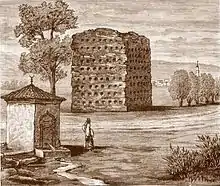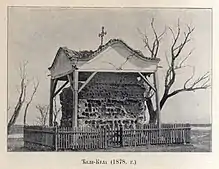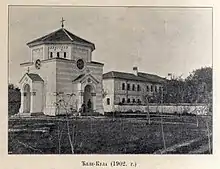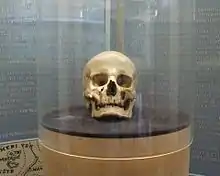Skull Tower
Skull Tower (Serbian Cyrillic: Ћеле Кула, romanized: Ćele kula, pronounced [tɕel̩e kula]) is a stone structure embedded with human skulls located in Niš, Serbia. It was constructed by the Ottomans following the Battle of Čegar of May 1809, during the First Serbian Uprising. During the battle, Serbian rebels under the command of Stevan Sinđelić were surrounded by the Ottomans on Čegar Hill, near Niš. Knowing that he and his fighters would be impaled if captured, Sinđelić detonated a powder magazine within the rebel entrenchment, killing himself, his subordinates and the encroaching Ottoman soldiers. The governor of the Rumelia Eyalet, Hurshid Pasha, ordered that a tower be made from the skulls of the fallen rebels. The tower is 4.5 metres (15 ft) high, and originally contained 952 skulls embedded on four sides in 14 rows.
| Skull Tower | |
|---|---|
 Detail of a tower wall | |
| Location | Niš, Serbia |
| Coordinates | 43.3122°N 21.9238°E |
| Built | 1809 |
| Visitors | 30,000–50,000 (in 2009) |
 Location of Skull Tower in Serbia | |
Following the Ottomans' withdrawal from Niš in 1878, the tower was roofed over, and in 1892 a chapel was built around it. In 1937, the chapel was renovated. A bust of Sinđelić was added the following year. In 1948, Skull Tower and the chapel enclosing it were declared Cultural Monuments of Exceptional Importance and came under the protection of the Socialist Republic of Serbia. Further renovation of the chapel occurred again in 1989. As of 2013, 58 skulls remain embedded in Skull Tower's walls. The one that is said to belong to Sinđelić is enclosed in a glass container adjacent to the structure. Seen as a symbol of independence by Serbs, the tower is mentioned in the writings of the French Romantic poet Alphonse de Lamartine and the English travel writer Alexander William Kinglake. In the two centuries since its construction, it has become a popular tourist attraction, visited by between 30,000 and 50,000 people annually.
History

The Ottoman Empire was known to create tower structures from the skulls of rebel fighters in order to elicit terror among its opponents.[1] The First Serbian Uprising against Ottoman rule erupted in February 1804, with Đorđe Petrović (Karađorđe) as its leader.[2] On 19 May 1809, 3,000 Serbian rebels under the command of Stevan Sinđelić were attacked by the Ottomans on Čegar Hill, in Niš. The rebels were plagued by lack of coordination, largely due to the rivalry between commanders Milivoje Petrovic and Petar Dobrnjac. As a result, Sinđelić's fighters failed to receive support from the other rebel detachments.[3] The numerically superior Ottomans lost thousands of soldiers in a number of failed attacks against the rebels, but eventually overwhelmed the Serbian lines. Knowing that he and his men would be impaled if captured, Sinđelić fired at his entrenchment's gun powder magazine, setting off a massive explosion. The resulting blast killed him and everyone else in the vicinity.[4][5][6][7]

After the battle, the governor of the Rumelia Eyalet, Hurshid Pasha, ordered that the heads of Sinđelić and his men be skinned, stuffed and sent to the Ottoman sultan, Mahmud II. Upon being viewed by the sultan, the skulls were then returned to Niš, where the Ottomans built the Skull Tower as a warning to non-Muslim residents contemplating rebellion.[6] The structure is 4.5 metres (15 ft) high.[8] It originally consisted of 952 skulls embedded on four sides in 14 rows.[6] The locals named it Ćele kula, from the Turkish Kelle kulesi, which means "skull tower".[4] In the years following its construction, many skulls fell out from the tower walls, some were taken away for burial by relatives thinking they could identify the skulls of their deceased family members, and some were taken by souvenir hunters.[9] Midhat Pasha, the last Ottoman governor of Niš, ordered that the remaining skulls be removed from the tower in the early 1860s. He realized that the structure no longer served as an effective means of discouraging potential rebels and only fostered resentment against the Ottoman administration, reminding locals of the empire's past cruelty.[10]

After the Ottomans withdrew from Niš in 1878, the Royal Serbian Army began scouring the town and its surroundings in search of the missing skulls. Some were found buried; one was found embedded deep inside the tower walls and sent to the National Museum in Belgrade. This was followed by the construction of a roof baldachin, which was topped off with a cross. The foundations of the chapel, designed by the architect Dimitrije T. Leko, were consecrated in 1894.[10] A plaque dedicated near the chapel in 1904 reads: "To the first Serbian liberators after Kosovo."[9] The chapel was renovated in 1937 and a bust of Sinđelić was added the following year. In 1948, Skull Tower and the chapel enclosing it were declared Cultural Monuments of Exceptional Importance and came under the protection of the Socialist Republic of Serbia. Further renovation of the chapel occurred again in 1989.[11] As of 2014, 58 skulls remain embedded in the tower walls. The one that is said to belong to Sinđelić rests in a glass container.[9]
Legacy
In the centuries following its construction, Skull Tower has become a place of Serb pilgrimage.[9] In Serbia, and among Serbs both inside and outside the country, it is considered a symbol of the country's struggle for independence from the Ottoman Empire.[12] In the early 1830s, the French Romantic poet Alphonse de Lamartine wrote of the tower upon visiting Niš, which was at the time still part of the Ottoman Empire, saying:
I saw a large tower rising in the midst of the plain, as white as Parian marble ... [R]aising my eyes to the monument, I discovered that the walls, which I supposed to be built of marble or white stone, were composed of regular rows of human skulls; these skulls bleached by the rain and sun, and cemented by a little sand and lime, formed entirely the triumphal arch which now sheltered me from the heat of the sun. In some places portions of hair were still hanging and waved, like lichen or moss, with every breath of wind. The mountain breeze, which was then blowing fresh, penetrated the innumerable cavities of the skulls, and sounded like mournful and plaintive sighs. My eyes and my heart greeted the remains of those brave men whose cut-off heads made the cornerstone of the independence of their homeland. May the Serbs keep this monument! It will always teach their children the value of the independence of a people, showing them the real price their fathers had to pay for it.[6]

Skull Tower was also mentioned in the works of the British travel writer Alexander William Kinglake, published in 1849.[13] An exhibition at the Military Museum in Belgrade contains a replica of the tower.[7] Prior to the breakup of Yugoslavia, tens of thousands of schoolchildren from across Yugoslavia visited the original in Niš.[9] Skull Tower remains one of the most visited tourist destinations in Serbia, attracting between 30,000 and 50,000 visitors annually.[11]
See also
- Sedlec Ossuary
- Capela dos Ossos
- Capuchin Crypt
- Skull Chapel in Czermna
- Tzompantli – Mesoamerican wooden rack or palisade used for the public display of human skulls, e.g. those of war captives or sacrificial victims
Notes
- Quigley 2001, p. 172.
- Judah 2000, p. 51.
- Damnjanović & Merenik 2004, pp. 65–66.
- Vucinich 1982, p. 141.
- Hall 1995, p. 297.
- Judah 2000, p. 279.
- Merrill 2001, p. 178.
- Hürriyet Daily News 27 February 2014.
- Judah 2000, p. 280.
- Makuljević 2012, pp. 36–37.
- Babović 14 July 2009.
- Levy 2015, p. 222.
- Longinović 2011, pp. 38–39.
References
- Babović, S. (14 July 2009). "Ćele-kula za svetsku baštinu" [Skull Tower as World Heritage]. Večernje novosti (in Serbian).
- Damnjanović, Nebojša; Merenik, Vladimir (2004). The First Serbian Uprising and the Restoration of the Serbian State. Belgrade, Serbia: Historical Museum of Serbia. ISBN 978-86-7025-371-1.CS1 maint: ref=harv (link)
- Hall, Brian (1995). Impossible Country: A Journey Through the Last Days of Yugoslavia. New York City: Penguin. ISBN 978-0-14-024923-1.CS1 maint: ref=harv (link)
- Judah, Tim (2000). The Serbs: History, Myth and the Destruction of Yugoslavia. New Haven, Connecticut: Yale University Press. ISBN 978-0-300-08507-5.CS1 maint: ref=harv (link)
- Levy, Michele Frucht (2015). "From Skull Tower to Mall: Competing Victim Narratives and the Politics of Memory in the Former Yugoslavia". In Mitroiu, Simona (ed.). Life Writing and Politics of Memory in Eastern Europe. New York City: Palgrave Macmillan. pp. 202–221. ISBN 978-1-137-48552-6.CS1 maint: ref=harv (link)
- Longinović, Tomislav (2011). Vampire Nation: Violence as Cultural Imaginary. Durham, North Carolina: Duke University Press. ISBN 978-0-8223-5039-2.CS1 maint: ref=harv (link)
- Makuljević, Nenad (2012). "Public Monuments, Memorial Churches and the Creation of Serbian National Identity in the 19th Century". In Zimmermann, Tanja (ed.). Balkan Memories: Media Constructions of National and Transnational History. Bielefeld, Germany: transcript Verlag. pp. 33–40. ISBN 978-3-8394-1712-6.CS1 maint: ref=harv (link)
- Merrill, Christopher (2001). Only the Nails Remain: Scenes from the Balkan Wars. Lanham, Maryland: Rowman & Littlefield. ISBN 978-0-74251-686-1.CS1 maint: ref=harv (link)
- "Ottoman tower tops list of buildings made with bones". Hürriyet Daily News. 27 February 2014.
- Quigley, Christine (2001). Skulls and Skeletons: Human Bone Collections and Accumulations. Jefferson, North Carolina: McFarland. ISBN 978-0-7864-1068-2.CS1 maint: ref=harv (link)
- Vucinich, Wayne S. (1982). "The Serbian Insurgents and the Russo-Turkish War of 1809–1812". In Vucinich, Wayne S. (ed.). First Serbian Uprising, 1804–1813. New York City: Columbia University Press. pp. 141–174. ISBN 978-0-930888-15-2.CS1 maint: ref=harv (link)
External links
| Wikimedia Commons has media related to Ćele-kula. |
